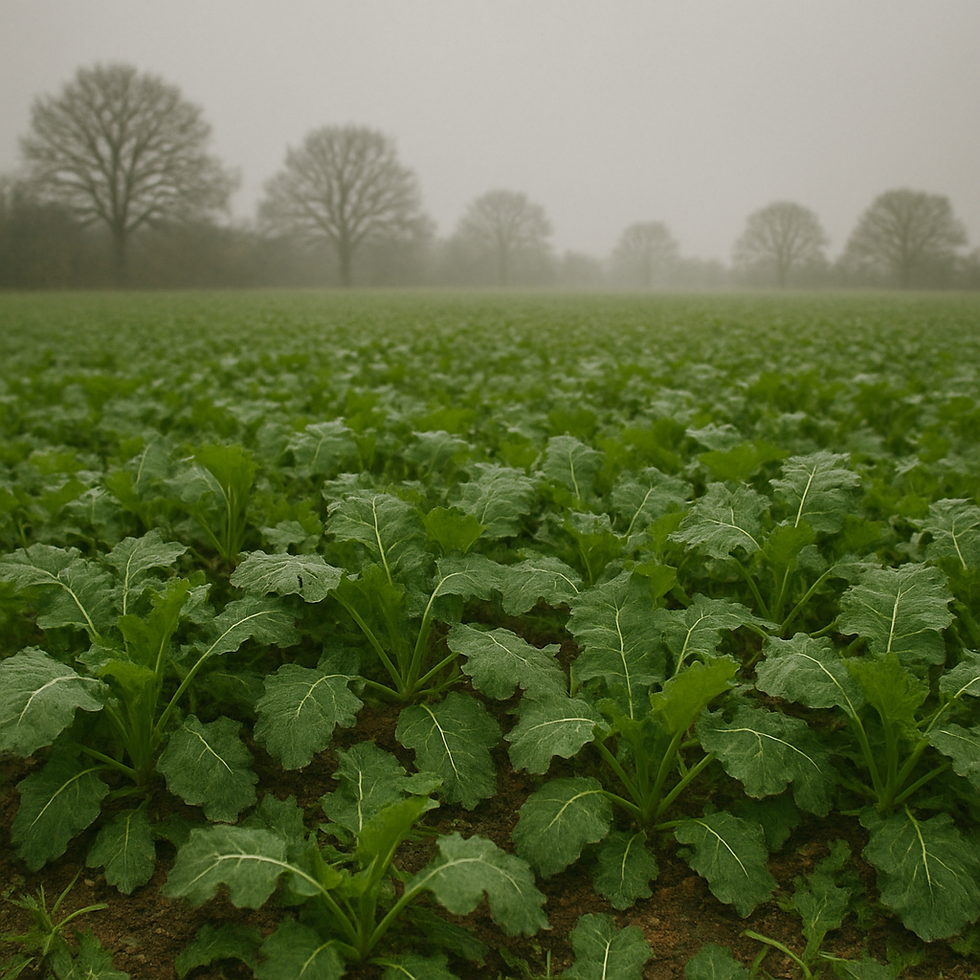The Frost Bacterium That Feeds Crops
- Soil Fertility Services Ltd

- Oct 20
- 4 min read
The Microbe That Both Makes and Stops Frost
Pseudomonas fluorescens.
There’s a bacterium that can make ice. Not metaphorically — literally. Its name is Pseudomonas fluorescens, and for years it’s been the pantomime villain of the horticultural world, blamed for those annoying early frosts that turn bean leaves into mush and make lettuce look like someone’s hit “defrost” on the fridge.
And yet, in one of nature’s finest plot twists, the very same species is now being used to prevent frost, protect roots, release nutrients, and even prime a crop’s immune system. Same microbe. Different attitude.
The frost paradox
Certain strains of Pseudomonas fluorescens possess special surface proteins known as ice-nucleation proteins. These little microbes can cause water molecules to align into neat rows, triggering ice formation at temperatures as mild as –2 °C. It’s clever biophysics, and it’s why some bacterial cells can seed ice crystals in clouds and on leaves alike.
But not all P. fluorescens are built that way. Many are non-ice-nucleating strains (INA), genetically distinct, harmless, and in some cases, actively helpful. When these “ice-minus” strains colonise the leaf surface, they push out their frost-causing cousins by simple competition. They take the same space, feed on the same sugary exudates, and leave the troublemakers homeless. Fewer ice nuclei mean fewer crystals form when temperatures drop, providing the crop with a few crucial degrees of protection.
It’s microbial crowd control: instead of stopping frost with heaters or sprays, the plant hires bouncers.
This is where the story really takes off. The same P. fluorescens that’s up on the leaf doing frost prevention is also, below ground, a hard-working member of the soil workforce.
Down in the rhizosphere, that bustling layer of life clinging to roots, P. fluorescens takes on a different role:
It produces siderophores, which hoard iron and starve pathogens like Rhizoctonia and Pythium.
It secretes antibiotics and enzymes that keep fungal infections in check.
It triggers induced systemic resistance (ISR), priming the plant’s immune system so it responds faster to stress.
And it releases organic acids and phosphatases that unlock phosphorus, zinc, and other nutrients tied up in the soil.
So yes — the same species that once froze your sugar beet leaves can now help your wheat and carrots shrug off cold nights. Context is everything.
It’s worth noting that glyphosate doesn’t do Pseudomonas fluorescens any favours; several studies show its populations drop sharply after spraying, cutting the very biological bridge that helps free nutrients and defend against root pathogens.

How SFS harnesses it
At Soil Fertility Services, we use carefully selected non-ice-nucleating strains of Pseudomonas fluorescens in two key formulations:
Here, P. fluorescens joins forces with Bacillus, Cellulomonas, and Azotobacter species in our Megabactors consortium. Together they break down organic matter, solubilise phosphorus, and make locked-up minerals available. P. fluorescens plays a catalytic role, dissolving mineral P, improving root architecture, and quietly raising nutrient efficiency across the board.
In this blend, P. fluorescens focuses on the defensive side. It forms biofilms around roots, suppresses soil-borne pathogens, and boosts nutrient uptake efficiency. When conditions become cold or dry, those roots remain more active, providing the crop with better resilience and faster recovery once warmth returns.
Both products contain strains that don’t trigger frost, and can even help reduce frost risk on the leaf surface if populations persist through the canopy.
Why it matters
This isn’t academic trivia. Every year, UK growers lose margin to weather stress, nutrient lock-up, and disease carry-over. Beneficial Pseudomonas help on all three fronts, improving nutrient flow, strengthening plant health, and even offering a bit of microbial frost insurance.
In systems where synthetic fertiliser inputs are being trimmed, every bit of biological efficiency counts. The more active your rhizosphere, the better your crop weathers the season.
Soil to sky: a bacterial feedback loop
There’s something poetic about it, really. The same bacterium that helps ice crystals form in the clouds also helps plant cells stay unfrozen on the ground.It’s a living connection between soil and weather, a reminder that microbes don’t stop at the surface. They rise, fall, and cycle between earth and air, linking the carbon, water, and nutrient systems that keep everything alive.
Next time a frost warning flashes on your phone, remember: some of your best defences might already be in place, invisible, and very much alive.
Further reading
If you’d like to dig into the science behind this frost-maker-turned-frost-breaker, these are excellent places to start:
Biological frost control strategies reduce crop damage — overview of beneficial bacteria displacing ice-nucleating populations (University of California, ANR)
Preventing frost damage with bacterial help — field use of P. fluorescens for frost mitigation (Novum Life Sciences, 2023)
Ice-nucleating activity of Pseudomonas fluorescens — foundational lab study on frost-active strains (Journal of General Microbiology, 1987)
History of Discovery and Environmental Role of Ice-Nucleating Bacteria — detailed scientific review (Phytopathology, 2022)




Comments